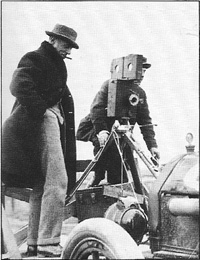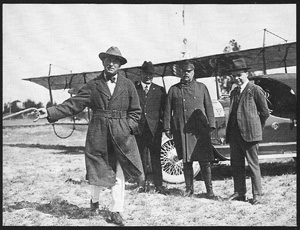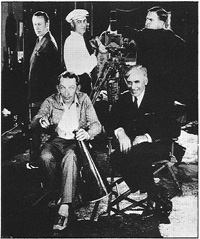Cinema in the 1910s
At the beginning of the 1910s, the most powerful forces in the American film industry were the members of the Motion Picture Patents Company (MPPC), often simply called “the Trust.” Led by the Thomas Edison’s company and the Biograph studio, the MPPC aimed to shut out competition through, first, the pooling of patents (e.g. film sprocket holes, camera parts) and later, control over networks of film distribution. Unaffiliated companies (the “independents”) banded together to form the Motion Picture Distribution and Sales company (Sales Co.) in 1910.
The Aitkens, having been for years connected with a number of independent film companies, aligned with the Sales Co. Internecine strife led to its dissolution two years later, with two companies—Universal and Mutual—emerging in its wake. The latter was led by the Aitken brothers. As a result of a falling out with their business partner, the Aitkens left Mutual in 1915. With them went the film companies or units of D.W. Griffith, Thomas Ince, and Mack Sennett. From this exodus the Triangle Film Corporation was formed to produce and distribute the works of this triumvirate. All three filmmakers left the corporation by the end of the decade.
1906

- John R. Freuler, Harry Aitken, and Roy Aitken form Western Film Exchange in Milwaukee.
1908
- D.W. Griffith (far left of image) begins directing at Biograph.
- Numerous companies, led by Edison and Biograph, form the MPPC.
1909
- Independent Moving Pictures (IMP), formerly Yankee Film Company, is founded by Carl Laemmle in NYC. It employs Florence Lawrence, formerly known as “The Biograph Girl” and arguably the first movie star. Studio gives actors screen credit, helping institute the star system.
- Edwin Thanhouser forms Thanhouser Company in NYC.
- Fatty Arbuckle begins work at Selig Polyscope Company.
- Adam Kessel and Charles Baumann form New York Motion Picture Company.
1910
- Motion Picture Distributing and Sales Company (Sales Co.) is established by independent producers to combat the MPPC. Initial founders: Carl Laemmle, Kessel, and Baumann.
- In part to provide product for Sales Co. to distribute, Freuler and Harry Aitken of Western Film Exchange join with Charles Hite and Samuel Hutchinson to form American Film Manufacturing Company (“The Flying A”) in Chicago.
- The General Film Company is established to serve as distribution arm of MPPC. It consolidates regional exchanges to become the first nationwide distribution company.
- IMP moves to Los Angeles.
- Thomas Ince joins IMP as a director, following brief stints at Biograph and IMP as a performer.
- Mary Pickford joins Biograph in January and leaves in December.
- Reliance Pictures founded by Baumann and Kessel.
1911

- Ince (in image, left) joins NYMPC. There he works on westerns in the Bison unit and forms the Kay-Bee unit, which specializes in dramas.
- Mack Sennett begins acting work at Biograph.
- Harry Aitken forms Majestic Studio with Thomas Cochrane of IMP. Talent includes Mary Pickford. Aitken also buys Reliance Company from Baumann.
- Pickford joins IMP.
1912
- The Flying A moves from Chicago to Santa Barbara, California.
- Thanhouser sells interest in Thanhouser Company to Hite.
- Sennett, with backing from NYMPC heads Kessel and Baumann establish Keystone Studios in Edendale, California.
- Indicative of independents’ unhappiness with Sales Co. distribution policies (esp. preferential treatment of Laemmle), Aitken expands Western Film Exchange holdings to form Mutual Film Corporation. Mutual distributes films of Thanhouser, Princess, American, Reliance, Komic, Majestic, Kay-Bee, Broncho, Domino, Apollo, Keystone, Signal, Vogue, Lone Star, and Continental.
- Under Laemmle’s leadership, IMP and eight other small companies are absorbed into production-distribution firm Universal Film Manufacturing Company. Studios absorbed include: NYMPC, Nestor, Champion, Powers, Éclair, Rex, and IMP.
- Pickford returns to Biograph, then leaves film industry for theater work.
1913
- Arbuckle joins Sennett at Keystone and gains fame in Keystone Kops comedies.
- Pickford accepts contract with Famous Players Corporation (later Famous Players-Lasky). Films distributed on states’ rights basis.
1914
- Griffith, desiring to make features full-time, takes his unit and forms Reliance-Majestic studio with Harry Aitken. Studio, later renamed Fine Arts, joins Mutual Film Corporation.
- William S. Hart makes his screen debut in NYMPC’s His Hour of Manhood, an Ince production.
- Paramount begins distributing Famous Players films.
1915
- In Mutual Film Corporation v. Industrial Commission of Ohio, the US Supreme Court rules that free speech protections do not cover motion pictures.
- A federal court finds the MPPC guilty of violating the Sherman Antitrust Act.
- Freuler stages hostile takeover of Mutual.
- Ince (New York Motion Picture Company), Griffith (Reliance-Majestic), and Sennett (Keystone) – all associated with Mutual – form Triangle Film Corporation, a production-distribution firm. Financial backing is supplied by Harry Aitken, Kessel, and Baumann. Roy Aitken and Harry Aitken, free from positions at Mutual, run business end of Triangle.
1916
- Charlie Chaplin accepts contract with Mutual. Resulting films, produced by Lone Star, include Easy Street and The Immigrant.
- Mary Pickford negotiates new contract with Famous Players. She receives her own studio unit, the Mary Pickford Film Corporation, and a boutique distributor, Artcraft.

1917
- Arbuckle leaves Keystone/Triangle for a contract with Paramount to form his own production company, Comique. There he makes two-reelers with a young Buster Keaton.
- Chaplin leaves Mutual for contract with First National.
- Griffith and Reliance-Majestic leave Triangle.
- Sennett leaves Keystone and forms Mack Sennett Comedies Corporation, making shorts and features distributed by First National and later Paramount.
- Hart leaves NYMPC/Triangle for contract with Famous Players-Lasky.
1918
- Mutual becomes insolvent.
- Ince sells his interest in Triangle and forms Thomas H. Ince Studios, active from 1919-1924.
- With all founding talent gone, Triangle ceases significant filmmaking activities. Samuel Goldwyn acquires studio facilities.
1919
- The Mary Pickford Company operates independently from Famous Players, distributing through First National.
- Griffith, Chaplin, Pickford, and Douglas Fairbanks form producer-distributor United Artists Corporation.
Bibliography
Bennett, Carl. Silent Era: the Silent Film Website. http://www.silentera.com
Bowser, Eileen. The Transformation of Cinema: 1907-1915. Vol. 2 of History of the American Cinema, ed. Charles Harpole. Berkeley: University of California Press, 1990.
Koszarski, Richard. An Evening’s Entertainment: The Age of the Silent Feature Picture, 1915-1928. Vol. 3 of History of the American Cinema, ed. Charles Harpole. Berkeley: University of California Press, 1990.
Lyons, Timothy James. The Silent Partner: The History of the American Film Manufacturing Company. New York: Arno Press, 1974.
